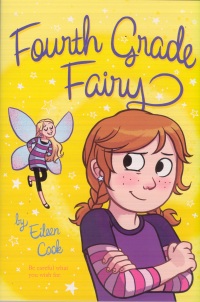| ________________
CM . . . . Volume XVIII Number 3 . . . . September 16, 2011
excerpt:
Ten year-old Willow Doyle comes from a long line of fairy godmothers. She attends a magical school, has a sister who can fly, and is only allowed to interact with her own kind. The problem is: Willow is fascinated by humans and desperately wants to be like them. When her grandmother, a principal of a “Humdrum” (human) school, gives her permission to attend regular elementary school for two weeks as a birthday gift, Willow jumps at the chance to befriend human girls. Things don’t go as planned, and misadventures ensue as Willow discovers that fitting in with humans isn’t all it’s cracked up to be. Fairies must be hot right now because Cook is very clearly jumping on a bandwagon with this offering. Almost every aspect of this book is derivative and unoriginal, from the magical school to the lingo for non-fairies. It’s as if Cook is working off a checklist for elements that work in this type of fantasy-meets-reality middle grade fiction. Off-kilter character names? Check. Talking animals? Check. Starting every chapter with a list? Check. Jumping on a kidlit bandwagon is not necessarily a bad thing, but the problem here is that it’s so poorly executed. The bulleted (or numbered, sometimes) lists with which Willow begins every chapter serve no real narrative purpose: the book is not structured like a diary, so why begin every chapter as if Willow is writing to herself? Likewise, the plot is so rushed that I had a hard time deciding whether it’s meant to be episodic or have an actual arc. Lots of things happen – Willow discovers she can talk to animals; a magic doctor turns her hair pink; her sister almost gets eaten by a lizard – but Cook never draws anything out to any sort of genuine comic or emotional affect, and her attempts to make the fairy world appropriately quirky are uninteresting and clichéd. The plot moves rapidly from one event to another, leaving a handful of confusing loose ends along the way, and there is a very awkward scurry to create a moral (Be careful what you wish for! Your family loves you no matter what!) at the end. There are hundreds of children’s books about fairies, and it surely is possible to stand out even if you have to recycle old tropes and traditions. Fourth Grade Fairy fails to do this. It’s stale, uneven, and sadly lacking in whimsy. Not recommended. Mark Elizabeth Walker is a teacher-librarian in Vancouver, BC.
To comment
on this title or this review, send mail to cm@umanitoba.ca.
Copyright © the Manitoba Library Association. Reproduction for personal
use is permitted only if this copyright notice is maintained. Any
other reproduction is prohibited without permission.
NEXT REVIEW |
TABLE OF CONTENTS FOR THIS ISSUE
- September 16, 2011.
AUTHORS |
TITLES |
MEDIA REVIEWS |
PROFILES |
BACK ISSUES |
SEARCH |
CMARCHIVE |
HOME |
